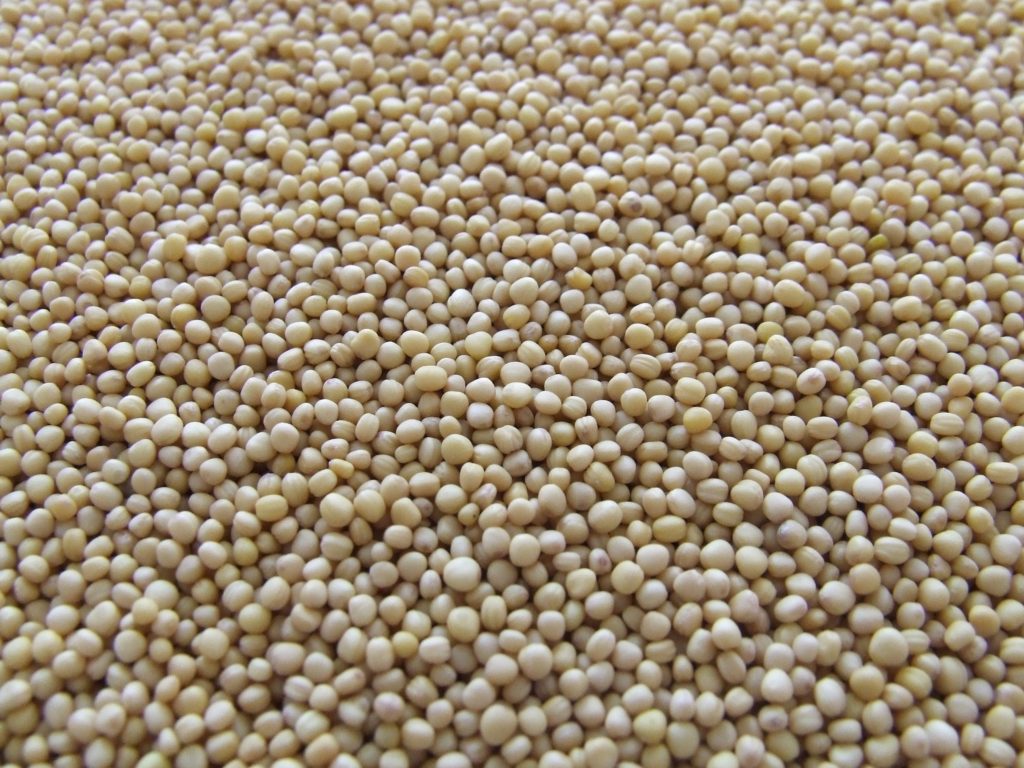Soy is widely sold as a health food and beverage in the United States and around the world. Today, most soy on the market is from genetically modified (GM) seed. 91 percent of soybeans planted in the United States are Genetically Modified, and the rate is rapidly growing throughout the world, according to Natural News newsletter.(1) Dr. Gregory Damato points out that “more than 95 per cent of GM soy (and 75 per cent of other GM crops) is engineered to tolerate glyphosate herbicide, the most common formulation of which is Roundup.” (2)
Recent studies by French scientists on the Toxicity of Roundup and Glyphosate found this herbicide carcinogenic. (3) They found:
- “Causes cell cycle dysregulation, which is a hallmark of tumor cells and human cancers
- Inhibits DNA synthesis in certain parts of the cell cycle—the process by which cells reproduce that underlies the growth and development of all living organisms.
- Impedes the hatchings of sea urchins. (Sea urchins were used because they constitute an appropriate model for the identification of undesirable cellular and molecular targets of pollutants.) The delay was found to be dose dependent on the concentration of Roundup. The surfactant polyoxyethylene amine (POEA), another major component of Roundup, was also found to be highly toxic to the embryos when tested alone, and could therefore be a contributing factor” (4)
These are just more reasons why I don’t eat or drink soy, if I can possibly avoid it or any other genetically modified food or non-organically grown food.
Recently (May 12, 2015), Germany’s state consumer protection ministers are calling for a European Union -wide ban on the leading global pesticide Glyphosate, since it was categorized as carcinogenic by the World Health Organization. (5) Glyphosate is marketed under the name of Round-up. This is one of the reasons we as consumers need to demand labeling of genetically modified foods in everything and everywhere. I highly recommend reading more about glyphosate herbicide if you are eating non-certified organic foods.
Just recently, the country of Bermuda banned Round-up. Here is the news release: http://www.royalgazette.com/article/20150511/NEWS/150519966
Beware that soy is added to tortillas, breads, fake meats, and many other foods, supposedly for the “health” benefit. In my opinion it is really used just used as cheap filler.
Health and nutrition expert Dr. Joseph Mercola writes that the advertising industry has really misled the public about the safety and health benefits of soy, as well as the widespread use of it in the Asian diet. He states: “A study of the history of soy use in Asia shows that the poor used it during times of extreme food shortage, and only when the soybeans were carefully prepared (e.g. by lengthy fermentation) to destroy the soy toxins.”(6) He goes on to say that contrary to some reports in the West, it is not the usual practice in Asian countries to feed soy milk to infants.(7)
There is a billion-dollar industry that advertises soy as a health answer to many health issues. Soy is frequently touted as being the answer to women’s menopause problems, heart disease, and weight problems, as well as a great protein source. Be aware of this when you are reading food labels that refer to soy having health benefits, even those that display an FDA-approved statement that soy can help lower the risk of heart disease. In 2000, two FDA employees, Daniel Doerge and Daniel Sheehan, were worried enough about the danger of soy that they wrote a controversial letter to their employer, protesting the positive health claims for soy that the FDA was approving at the time.(8)
They wrote: “There is abundant evidence that some of the isoflavones found in soy, including genistein and equol, a metabolite of daidzen, demonstrate toxicity in estrogen sensitive tissues and in the thyroid. This is true for a number of species, including humans. Additionally, isoflavones are inhibitors of the thyroid peroxidase which makes T3 and T4. Inhibition can be expected to generate thyroid abnormalities, including goiter and autoimmune thyroiditis. There exists a significant body of animal data that demonstrates goitrogenic and even carcinogenic effects of soy products. Moreover, there are significant reports of goitrogenic effects from soy consumption in human infants.”(9)
Think carefully about the effects that soy can have on the thyroid, (one of our master glands, which affect almost all aspects of our health) and estrogen. So many doctors and nutritionists are soy proponents. Be careful, and research this yourself if you are concerned.
“One of the reasons soy is touted as a great health food is because it is said to help with menopause hormone imbalances. This is one of the reasons why so many doctors and older women were so happy to embrace it. Soy and soy-based products contain isoflavones or phytoestrogens, which are plant-based estrogens. Soy is not the only food that contains phytoestrogens. There are other, less controversial, and more digestible foods with phytoestrogens that you can include in your diet. (For more information on phytoestrogens, see “Phytoestrogens and Breast Cancer—Fact Sheet #01” in “Resources.”)
For men, eating soy isoflavones can significantly reduce testicular function and lower luteinizing hormone (LH) production, which is what signals the testicles to work. A high soy intake and potentially lower level of LH increases the probability of estrogen dominance in men, contributing to hair loss, swollen and cancerous prostates, and insulin resistance. Doris Rapp, MD, a leading pediatric allergist, asserts that environmental and food estrogens are responsible for the worldwide reduction in male fertility.”(10)
Soy consumption has been linked with cancer in adults, notably breast cancer, as I read in an article by Jim Rutz. He went on to say:
That’s why the governments of Israel, the UK, France and New Zealand are already cracking down hard on soy. . . .
In sad contrast, 60 percent of the refined foods in U.S. supermarkets now contain soy. Worse, soy use may double in the next few years because (last I heard) the out-of-touch medicrats in the FDA hierarchy are considering allowing manufacturers of cereal, energy bars, fake milk, fake yogurt, etc., to claim that “soy prevents cancer.” It doesn’t. . . .
P.S.: Organic, non gmo soy sauce is fine. Unlike soy milk, it’s perfectly safe because it’s fermented, which changes its molecular structure. Miso, natto and tempeh are also OK, but avoid tofu.(11)
It is also important to be aware that soy can create allergic reactions. In 1986, Stuart Berger, MD, placed soy among the top seven allergens, one of the “sinister seven.”
These are all reasons why I don’t consume soy.
This is food for thought.
copyright@nancyaddison2013
Check our Nancy’s Award-winning books on Amazon.
Please leave a comment and join the conversation!
Other sources:
1 & 2 -[i] Fallon, Sallon. “Soy’s Dark Side.”
3 -Journal of Toxicology and Environmental Health, Part B: Critical Reviews Volume 15, Issue 4, 2012, R. Belléabc*, J. Marcabc, J. Moralesabc, P. Cormierabc & O. Mulner-Lorillonabc, pages 233-237, Publishing models and article dates explained, Published online: 09 May 2012, Article Views: 332, http://www.tandfonline.com/doi/abs/10.1080/10937404.2012.672149
4- Mercola, Dr. Joseph, New Evidence Against These Cancer-Causing Foods – And the Massive Cover-Up Effort, Dr. Mercola’s website, June 09, 2012 ‘
5.German states call for ban on household pesticide
UR Active support, Germany, May 12, 2015, Dario Sarmadi translated from German by Erika Körner
6- Mercola, Dr. Joseph. “Learn the Truth About Soy: Just How Much Soy Do Asians Eat?” Dr. Mercola’s website. January 9, 2000. articles.mercola.com/sites/articles/archive/2000/01/09/truth-about-soy.aspx.
7- Fallon and Enig, “Soy’s Dark Side.”
8- Sheegan, Daniel M., and Daniel R. Doerge. Letter to Dockets Management Branch (HFA-305). February 18, 1999. The letter was posted on the abcnews.com website as “Scientists Protest Soy Approval.”
9-Bellatti, Andy. “You Ask, I Answer: Soy Portein Isolate.” Medpedia.com website. April 16, 2011. www.medpedia.com/news_analysis/98-Small-Bites/entries/71677-You-Ask-I-Answer-Soy-Protein-Isolate.
10 & 11- Rutz, Jim. “The Trouble with Soy.” World Net Daily website. www.wnd.com/news/article.asp?ARTICLE_ID=53327. 2010. This article was originally titled “Soy Is Making Kids ‘Gay’,” but after a huge backlash he re-titled it “The Trouble with Soy.”






For those of us who are passionate about the GMO issue and who have worked hard to raise awareness about it are often looking for the best ways to boycott GMOs. One of the most effective ways to put an end to any product you don’t want to see out there is to simply not support it. Opt out of it! Vote with your dollars. Avoid buying products or supporting any brands that use GMOs. Since there are huge numbers of people and companies against GMOs, there are plenty of options for almost any food product or health care product, so you can still buy something healthy and affordable while still avoiding GMOs…
Great information and a good reminder to check ingredients of the food we consume. Thanks Nancy
Nancy, thank you for keeping me focused on good food, nutritional and health. I have told you this before, you are instrumental in my weight loss regiment and your book. Maybe you could touch some more informational stuff about labeling…about eggs i.e. natural, free range, vegetarian chicken for these eggs what’s market hype and dis-information, and what’s accurate good information. I look at labels for no GMO’s and avoid products that don’t list this. Thank you for being on the front lines in health and nutrition.
I personally think this is a huge issue with our nutrition and why half the time I really don’t want to go out to eat. This was an amazing, well researched piece that I will be sharing with some of my friends. Thank you so much for providing this thorough piece!
Thank you so much Andrea for sharing those thoughts with us!
Thank you for writing this informative blog on weed killers. I am very much against weed killers which then goes right into the gutters & on into streams & rivers. Surely that can’t be good for the fish. I have also felt these weed killers kill our beautiful wild flowers which are so important for the bee and butterfly populations.
Several studies have found a slight increase in Non-Hodgkin’s lymphomas among ag workers, and this is statistically associated with the most common chemicals used, including glyphosate. That doesn’t prove that glyphosate usage caused the lymphoma, but it’s worth considering. Exposure to glyphosate is of course lower among those of us who just consume the treated products. It’s interesting to note that incidence of NHL has been essentially constant over the last 20 years, at about 20/100,00 men and women per year in the U.S. Mantle cell lymphoma is a small part of this total, and studies are even less clear because of its low incidence. Nevertheless, if we’re being exposed to increasing doses of glyphosate, it’s not at this time associated with an increasing rate of NHL.
Thank you for the great information. I always learn so much when I
read your articles.
I’m so glad I don’t use that. Thank you for the information.
The USDA just released news that they will help with planting of bee friendly plants on private property. They haven’t however banned the chemicals that are destroying the bees. What a mixed message!
We need to ban the toxic chemicals and also plant the plants to help them have abundant food.
Here is the news release from the USDA- http://www.nrcs.usda.gov/wps/portal/nrcs/detail/national/newsroom/releases/?cid=NRCSEPRD405226